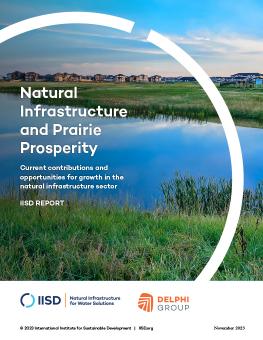
Natural Infrastructure and Prairie Prosperity
Current contributions and opportunities for growth in the natural infrastructure sector
The natural infrastructure sector contributes billions to the Prairie-wide economy and creates jobs. In 2022, the sector's direct contribution to the GDP of the Canadian Prairies was estimated to be CAD 4.1 billion, and it directly employed over 33,000 people in Alberta, Saskatchewan, and Manitoba. We need greater investment in this sector, which is required to treat and supply clean, fresh water to the millions who live in Canada's Prairies.
-
The natural infrastructure sector contributes billions to the Prairie-wide economy and creates jobs. We need more investment in this sector, which is required to treat and supply clean, fresh water to the millions who live on Canada's Prairies, as well as to protect them from natural disasters.
-
CAD 4.1 billion. The estimated direct contribution to the GDP of the Canadian Prairies in 2022 by the natural infrastructure sector. It's also estimated the sector directly employed over 33,000 people in Alberta, Saskatchewan, and Manitoba.
-
Natural Infrastructure investments support greater resiliency in the face of floods, droughts, fires, and other severe weather impacts-important across the Prairies, which faced devastating droughts and fires in 2023.
Natural infrastructure contributes over CAD 4 billion annually to the economy of Canada’s Prairies, as well as tens of thousands of jobs. There’s still room for growth: more investment can build greater resilience to droughts, floods, fires, and other severe weather impacts—many of which afflicted the region this summer—as well as increase jobs and GDP.
In Alberta, Saskatchewan, and Manitoba, it is estimated that this sector directly employed more than 33,000 people and contributed over CAD 4.1 billion to Prairie-wide GDP in 2022. With additional investments across the Prairie provinces of CAD 40 million to CAD 100 million per year, the sector could see between 18% and 25% in direct job growth by 2030 compared to business as usual.

Natural infrastructure involves the conservation, restoration, or enhancement of natural landscapes to provide specific results. For example, wetlands can naturally house excess water during floods; green roofs can help manage runoff; and forests, grasslands, and restored stream banks can replenish groundwater, mitigate flood- and drought-related risks, support fisheries, and provide opportunities for recreation. The sector employs a variety of workers, including landscape architects, ecologists, urban planners, stormwater managers, and environmental consultants.

Funded by
You might also be interested in
The State of Play of Natural Infrastructure on the Canadian Prairies
We sat down with key experts across the region and reviewed the latest literature to determine how we take natural infrastructure from novel to normal on Canada's Prairies.
What Is the UAE Framework for Global Climate Resilience, and How Can Countries Move It Forward?
With the introduction of the new framework for the Global Goal on Adaptation (GGA), COP 28 marked a milestone for adaptation. We unpack key outputs and set out how countries can move forward by strengthening their national monitoring, evaluation, and learning (MEL) systems.
Essential Monitor's Guide for Prairie Water Retention
This guidance document aims to make water retention monitoring a more accessible practice from a technical standpoint by demystifying some of the considerations required to get started.
'Car without wheels': Adaptation playbook lacks finance target
Governments at the COP 28 climate talks in Dubai have agreed on a playbook for adapting to climate change in areas like health, protecting nature and food and water security. But while wealthy countries celebrated the agreement, developing and particularly African countries denounced the absence of a target to provide financial and other forms of support.
